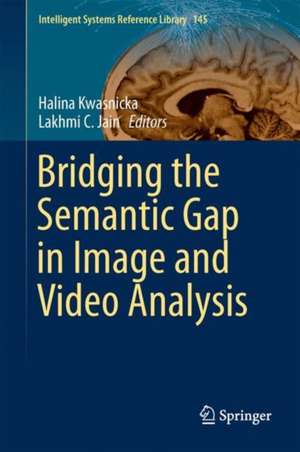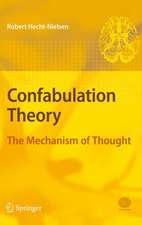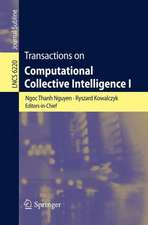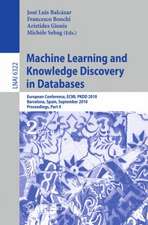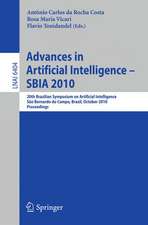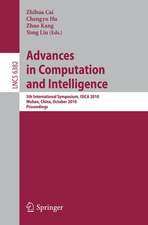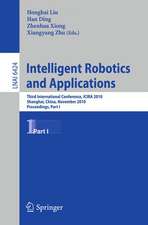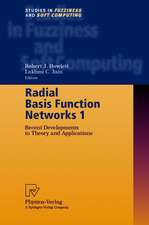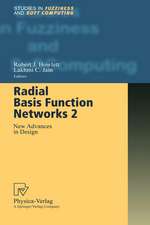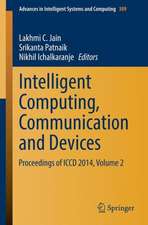Bridging the Semantic Gap in Image and Video Analysis: Intelligent Systems Reference Library, cartea 145
Editat de Halina Kwaśnicka, Lakhmi C. Jainen Limba Engleză Hardback – mar 2018
The semantic gap is a challenging area of research, and describes the difference between low-level features extracted from the image and the high-level semantic meanings that people can derive from the image. The result greatly depends on lower level vision techniques, such as feature selection, segmentation, object recognition, and so on. The use of deep models has freed humans from manually selecting and extracting the set of features. Deep learning does this automatically, developing more abstract features at the successive levels.
The book offers a valuable resource for researchers, practitioners, students and professors in Computer Engineering, Computer Science and related fields whose work involves images, video analysis, image interpretation and so on.
| Toate formatele și edițiile | Preț | Express |
|---|---|---|
| Paperback (1) | 326.46 lei 43-57 zile | |
| Springer International Publishing – 24 ian 2019 | 326.46 lei 43-57 zile | |
| Hardback (1) | 332.71 lei 43-57 zile | |
| Springer International Publishing – mar 2018 | 332.71 lei 43-57 zile |
Din seria Intelligent Systems Reference Library
- 20%
 Preț: 1050.57 lei
Preț: 1050.57 lei - 20%
 Preț: 1157.60 lei
Preț: 1157.60 lei - 20%
 Preț: 648.44 lei
Preț: 648.44 lei - 20%
 Preț: 650.08 lei
Preț: 650.08 lei - 20%
 Preț: 1005.64 lei
Preț: 1005.64 lei - 5%
 Preț: 968.88 lei
Preț: 968.88 lei - 20%
 Preț: 1052.67 lei
Preț: 1052.67 lei - 20%
 Preț: 1171.46 lei
Preț: 1171.46 lei - 20%
 Preț: 1164.84 lei
Preț: 1164.84 lei - 20%
 Preț: 815.83 lei
Preț: 815.83 lei - 20%
 Preț: 989.96 lei
Preț: 989.96 lei - 20%
 Preț: 1063.41 lei
Preț: 1063.41 lei - 20%
 Preț: 925.45 lei
Preț: 925.45 lei - 20%
 Preț: 504.37 lei
Preț: 504.37 lei - 18%
 Preț: 1113.26 lei
Preț: 1113.26 lei - 20%
 Preț: 1920.04 lei
Preț: 1920.04 lei - 20%
 Preț: 990.62 lei
Preț: 990.62 lei - 20%
 Preț: 651.57 lei
Preț: 651.57 lei - 20%
 Preț: 645.97 lei
Preț: 645.97 lei - 20%
 Preț: 660.16 lei
Preț: 660.16 lei - 20%
 Preț: 647.13 lei
Preț: 647.13 lei - 20%
 Preț: 654.05 lei
Preț: 654.05 lei - 20%
 Preț: 649.93 lei
Preț: 649.93 lei - 20%
 Preț: 648.11 lei
Preț: 648.11 lei - 20%
 Preț: 657.99 lei
Preț: 657.99 lei - 20%
 Preț: 656.84 lei
Preț: 656.84 lei - 20%
 Preț: 1624.04 lei
Preț: 1624.04 lei - 20%
 Preț: 642.98 lei
Preț: 642.98 lei - 20%
 Preț: 649.60 lei
Preț: 649.60 lei - 20%
 Preț: 651.23 lei
Preț: 651.23 lei - 20%
 Preț: 653.06 lei
Preț: 653.06 lei - 20%
 Preț: 1002.99 lei
Preț: 1002.99 lei - 20%
 Preț: 645.14 lei
Preț: 645.14 lei - 20%
 Preț: 658.33 lei
Preț: 658.33 lei - 20%
 Preț: 644.98 lei
Preț: 644.98 lei - 20%
 Preț: 646.62 lei
Preț: 646.62 lei
Preț: 332.71 lei
Preț vechi: 415.89 lei
-20% Nou
Puncte Express: 499
Preț estimativ în valută:
63.66€ • 66.65$ • 52.68£
63.66€ • 66.65$ • 52.68£
Carte tipărită la comandă
Livrare economică 07-21 aprilie
Preluare comenzi: 021 569.72.76
Specificații
ISBN-13: 9783319738901
ISBN-10: 3319738909
Pagini: 166
Ilustrații: X, 163 p. 59 illus., 48 illus. in color.
Dimensiuni: 155 x 235 mm
Greutate: 0.43 kg
Ediția:1st ed. 2018
Editura: Springer International Publishing
Colecția Springer
Seria Intelligent Systems Reference Library
Locul publicării:Cham, Switzerland
ISBN-10: 3319738909
Pagini: 166
Ilustrații: X, 163 p. 59 illus., 48 illus. in color.
Dimensiuni: 155 x 235 mm
Greutate: 0.43 kg
Ediția:1st ed. 2018
Editura: Springer International Publishing
Colecția Springer
Seria Intelligent Systems Reference Library
Locul publicării:Cham, Switzerland
Cuprins
Semantic Gap in Image and Video Analysis: An Introduction.- Low-Level Feature Detectors and Descriptors for Smart Image and Video Analysis: A Comparative Study.- Scale-insensitive MSER Features: A Promising Tool for Meaningful Segmentation of Images.- Active Partitions in Localization of Semantically Important Image Structures.- Model-based 3D Object recognition in RGB-D Images.- Ontology-Based Structured Video Annotation for Content-Based Video Retrieval via Spatiotemporal Reasoning.- Deep Learning – a New Era in Bridging the Semantic Gap.
Notă biografică
Professor Dr Halina Kwaśnicka is a Head of Department of Computational Intelligence at Wroclaw University of Science and Technology, Wroclaw, Poland and the Director of Graduate Schools. She was the Deputy Director for Scientific Researches of Institute of Informatics and the head of Division of Artificial Intelligence (in the Institute of Informatics).
Over time, her research interest has evolved from nature-inspired methods, data mining, and knowledge-based systems to methods of generation of hierarchies of groups of objects, in the further goal to use them in clustering text documents and images. Such a hierarchy of images projected on ontology could allow inferring semantic content.\
Professor Kwaśnicka was and is involved in the realization of scientific national and international projects, and published as an author or co-author more than 200 journal and conference papers and books.
Dr. Lakhmi C. Jain, PhD, ME, BE(Hons), Fellow (Engineers Australia) is with the Faculty of Education, Science, Technology & Mathematics at the University of Canberra, Australia and Bournemouth University, UK.
Professor Jain founded the KES International for providing a professional community the opportunities for publications, knowledge exchange, cooperation and teaming. Involving around 5,000 researchers drawn from universities and companies world-wide, KES facilitates international cooperation and generate synergy in teaching and research. KES regularly provides networking opportunities for professional community through one of the largest conferences of its kind in the area of KES.
His interests focus on the artificial intelligence paradigms and their applications in complex systems, security, e-education, e-healthcare, unmanned air vehicles and intelligent agents.
Over time, her research interest has evolved from nature-inspired methods, data mining, and knowledge-based systems to methods of generation of hierarchies of groups of objects, in the further goal to use them in clustering text documents and images. Such a hierarchy of images projected on ontology could allow inferring semantic content.\
Professor Kwaśnicka was and is involved in the realization of scientific national and international projects, and published as an author or co-author more than 200 journal and conference papers and books.
Dr. Lakhmi C. Jain, PhD, ME, BE(Hons), Fellow (Engineers Australia) is with the Faculty of Education, Science, Technology & Mathematics at the University of Canberra, Australia and Bournemouth University, UK.
Professor Jain founded the KES International for providing a professional community the opportunities for publications, knowledge exchange, cooperation and teaming. Involving around 5,000 researchers drawn from universities and companies world-wide, KES facilitates international cooperation and generate synergy in teaching and research. KES regularly provides networking opportunities for professional community through one of the largest conferences of its kind in the area of KES.
His interests focus on the artificial intelligence paradigms and their applications in complex systems, security, e-education, e-healthcare, unmanned air vehicles and intelligent agents.
Textul de pe ultima copertă
This book presents cutting-edge research on various ways to bridge the semantic gap in image and video analysis. The respective chapters address different stages of image processing, revealing that the first step is a future extraction, the second is a segmentation process, the third is object recognition, and the fourth and last involve the semantic interpretation of the image.
The semantic gap is a challenging area of research, and describes the difference between low-level features extracted from the image and the high-level semantic meanings that people can derive from the image. The result greatly depends on lower level vision techniques, such as feature selection, segmentation, object recognition, and so on. The use of deep models has freed humans from manually selecting and extracting the set of features. Deep learning does this automatically, developing more abstract features at the successive levels.
The book offers a valuable resource for researchers, practitioners, students and professors in Computer Engineering, Computer Science and related fields whose work involves images, video analysis, image interpretation and so on.
The semantic gap is a challenging area of research, and describes the difference between low-level features extracted from the image and the high-level semantic meanings that people can derive from the image. The result greatly depends on lower level vision techniques, such as feature selection, segmentation, object recognition, and so on. The use of deep models has freed humans from manually selecting and extracting the set of features. Deep learning does this automatically, developing more abstract features at the successive levels.
The book offers a valuable resource for researchers, practitioners, students and professors in Computer Engineering, Computer Science and related fields whose work involves images, video analysis, image interpretation and so on.
Caracteristici
Presents cutting-edge research on various ways to bridge the semantic gap in image and video analysis Explores the correspondence between the low-level information extracted from an image and the meaning that the image holds for the user Shows how to transform the representation computed from raw image data to the high-level representation of semantics performed by the image
